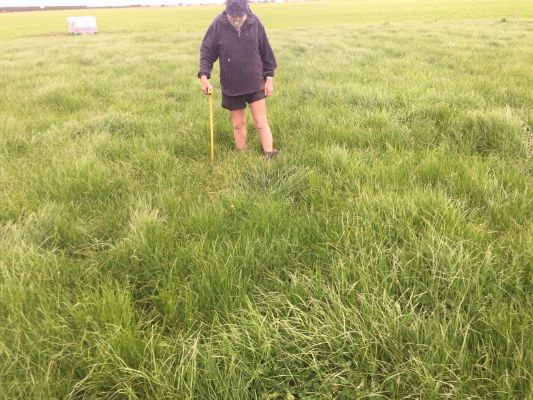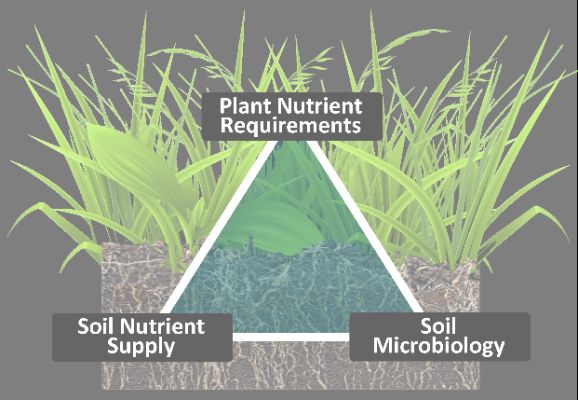New Technology Shown To Improve Pasture Growth Without Harming The Environment

Many of us are just beginning to understand how soils [and soil fertility] truly work. The dominant model, developed 150 years ago by chemists in Germany has been popularised, used very widely and successfully. This model says: “You have a soil that is deficient in nutrients. You are growing a plant that needs the nutrients to achieve full production. Nutrients or fertilisers are applied to correct the imbalance. If you have multiple deficiencies, then you may apply a cocktail of nutrients and fertilisers to address the balance”. Note that in this model the microbiological elements are ignored. More nutrients and chemicals are applied. The soil biology gets hammered. More maintenance nutrients are required - and so the costly circle continues.
The problem with this model is that it is deficient. It misses the critical component of soil microbiology. This has been substantially invisible until recently, when we have had a new tool, DNA to aid study. When you start to look at the interaction of soil microbiology, it has been a largely invisible third party in agriculture. In forestry it has long been known that nutrient deficiencies in plants can be solved by micro biology. Pine trees need mycorrhizal fungi. Without the fungi, the Pine tree doesn’t grow.

What we now have come to understand is that there is a three way system:.
- Plants and their nutrient requirements,
- Soil with its nutrient supply capabilities and
- Soil Microbes
The more we understand the more we come to see that soil microbes play a far more critical role than we previously thought.
To get maximum production requires thinking about how you influence the soil microbiology and how that affects your production system. One way to do this is to putting carbon into the roots which is like currency you pay the soil microbes with. Provide them with energy and they will provide water and nutrients.
So much of what we have done in the past has been to short circuit the process – it’s like using anabolic steroids to chuck the javelin down the track. Generally, we are farming on steroids on the old model (and degrading the soil microbes) rather than farming naturally.
An increasing number of farmers are starting to understand that microbiological activity in the soils should be encouraged to ensure healthy soils and improved plant growth. The challenge is to find the right tools and processes that can stimulate growth in a cost effective way while maintaining the environment and cost.
A New Zealand farmer has taken an additional concept that has its roots from the 1930’s, developed it for NZ conditions over the past ten years, and is providing it to farmers throughout the country with HydroBoost. In a nutshell, HydroBoost technology stimulates soil microbiology by energisation and altering ionic potentials in the soils soil water supply and this drives growth.
An independent scientific assessment of Hydroboost technology showed a 19% increase in pasture growth using energised water compared with non energised water. While research is ongoing the evidence so far shows Hydroboost increases in pasture growth at a minimal cost. It may also provide addition benefits such as increasing pasture energy in sugar content (brix value).
The increase in plant growth is not as a result of any increase of water – the large field trial used the same volume of water, therefore the results show that the energised water clearly provides a positive result. Other farmers commercially using the HydroBoost technology have reported that applied water volume can reduced, thus improving water efficiency and ensuing justifiable irrigation.
In another trial in the McKenzie Country with unfertilised low fertility native pasture a single application of Hydroboost gave an improvement of 7% grass The scientist running the trial commented ‘If a single application of energised water increased pasture yield by 7% after two years, this would be of commercial interest to farmers and merits further investigation’.
The farmers that have installed the HydroBoost technology have reported very good results. In addition to improving pasture growth, the energised water tends to stay in the root zone. A Hydroboost in-house trial recorded smoothing out of soil temperature variations. Not only has this lead to better growing conditions in the shoulder parts of the irrigation season, it has also enabled a reduction in applied water which may reduce leaching.

While there are a number of unexplained benefits, (and current research is continuing, there is preliminary evidence from another trial demonstrating up to a 29% increase in pasture growth when the Hydroboost water was mixed with Urea over the application of Urea without energised water, though results were variable.
From a wider perspective, farmers are being challenged by regulation and compliance to reduce their chemical exposure to the environment. In farms where the HydroBoost technology has been implemented, farmers know that the water feeding the stock troughs is energised, leading to reduced health issues with stock, the grass eaten has a higher brix value and in the case of dairy, reduced incidence of high Somatic cell counts. When the incremental benefits are spliced together, the overall result is that agricultural products are is being produced more efficiently, in harmony with the environment and guess what – that also translates potentially less harmful chemicals into the food supply.
As well as improved pasture growth, the technology has also been used to clean irrigation ponds with visible benefits and one farmer commenting on the results from cleaning a 4ha storage pond saying, “In the past, no-one would be brave enough to swim in it – now with the technology applied to the pond, children will now swim in it”.
While the HydroBoost product is not the magic bullet that rights all wrongs in the environment, the evidence shows the technology could be a significant tool that can improve productivity with less harmful effects on the environment. Surely, as our social awareness evolves with a greater focus being demanded by the planets inhabitants on sustainable agricultural products and processes, the HydroBoost technology is one which can greatly help farmers productivity, profitability and peace of mind.


 Broadcasting Standards Authority: Inaccurate 1News Reporting On Football Violence Breached Broadcasting Standards
Broadcasting Standards Authority: Inaccurate 1News Reporting On Football Violence Breached Broadcasting Standards Better Taxes for a Better Future: $1b Cut In Budget Operating Allowance ‘Unnecessary And Damaging’
Better Taxes for a Better Future: $1b Cut In Budget Operating Allowance ‘Unnecessary And Damaging’ Transport Well NZ: Transport Well New Zealand Charitable Trust - A Vision For The Entire Sector
Transport Well NZ: Transport Well New Zealand Charitable Trust - A Vision For The Entire Sector KiwiRail: Auckland Rail Network Reopens After Successful Upgrades
KiwiRail: Auckland Rail Network Reopens After Successful Upgrades ChargeNet: EV infrastructure co-funding model welcomed
ChargeNet: EV infrastructure co-funding model welcomed NZ Trucking Association: TruckSafe New Zealand Launches | A Game-Changer For Heavy Vehicle Safety And Compliance
NZ Trucking Association: TruckSafe New Zealand Launches | A Game-Changer For Heavy Vehicle Safety And Compliance